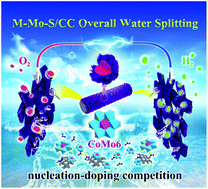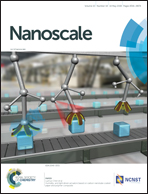Polyoxometalate precursors for precisely controlled synthesis of bimetallic sulfide heterostructure through nucleation-doping competition†
Abstract
Molybdenum disulfide (MoS2)-based bimetallic sulfides have drawn increasing research attention because of their unique structures and properties. Herein, a one-pot hydrothermal synthesis method is proposed to grow a series of bimetallic sulfides on carbon cloth (M–Mo–S/CC, M = Co, Ni, Fe) using Anderson-type polyoxometalates (POMs) as bimetallic sources for the first time. An ideal model of M–Mo–S/CC was used to study the growth process through the nucleation-doping competition mechanism. It is proved for the first time that M–Mo–S/CC possess certain compositions of bimetallic sulfides rather than metal doped MoS2 structures because the nucleation reaction is predominant in the nucleation-doping competition. Moreover, the nucleation rates of different metals can be compared to study the different morphologies of M–Mo–S/CC because Anderson-type POMs have fixed bimetal proportions and precise structures. Co–Mo–S and Ni–Mo–S show spherical heterostructures with CoS2 or NiS mainly inside and interconnected MoS2 nanosheets outside, while Fe–Mo–S exhibits uniform nanosheet morphology without stacking. As electrodes for alkaline water electrolysis, M–Mo–S/CC with different compositions and morphologies exhibit a variety of activities. Particularly, among the M–Mo–S/CC samples, Co–Mo–S/CC achieves the best performance for hydrogen evolution reaction, oxygen evolution reaction and overall water splitting. This study presents a facile strategy of using POMs as bimetallic precursors for studying the growth mechanism as well as the water electrolysis performances of MoS2-based bimetallic sulfides.



 Please wait while we load your content...
Please wait while we load your content...